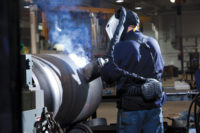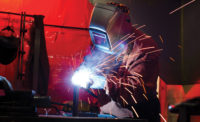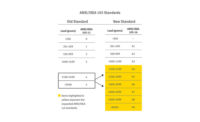Welding gloves can protect you from electric shock, flames, hot parts, sharp or flying metal, and arc rays. Proper gloves are the first line of defense against the hand hazards of welding and cutting. ANSI Standard Z49.1 requires that all welders and cutters wear protective gloves while working. Different processes may use different gloves. Some guidelines for selecting proper gloves for welding and cutting:
Nature of the hazard
• Mechanical hazards that cause cuts, scrapes, tears, and punctures.
• Thermal hazards such as heat, flames, hot parts, arc rays, fire, molten metal, spatter, slag, and sparks.
• Electrical hazards due to gloves that are wet, torn, damaged, or have insulation failure.
Glove requirements
Gloves should be:
• Dry and moisture resistant.
• In good condition, no holes or tears.
• Flame resistant.
• Comfortable--proper fit and size.
• Electrically and thermally insulated to suit the process.
• Flexible--allow easy movement and full range of motion.
• Made with materials, seams, and edges that do not affect the health or safety of the user.
• Durable, tough, and long lasting.
• Cut, scrape, tear, and puncture resistant.
Many materials are available. Each has properties affecting its performance and use. Here is a list of typical materials and their useful characteristics: properties affecting its performance and use. Here is a list of typical materials and their useful characteristics:
• Cowhide—tough, durable, flame and heat resistant, with good electrical resistance when dry.
• Calfskin—better dexterity than cowhide but not as tough.
• Pigskin—flexible, oil resistant, quick drying.
• Rubber— moisture proof, electrical insulation.
• Treated Cotton—absorbent, lightweight, flexible.
• Aluminized—heat resistant, reflects heat radiation.
• Goatskin—light weight, comfortable,
Glove design recommendations
There are many different styles of gloves. Some protect only the fingers and palms. Others protect the entire hand. Still others protect the wrist and forearm as well. Some gloves have combinations of material, such as cowhide palms and pigskin backs.
One pair of gloves may not be suitable for all processes. For example, gloves that are proper for low current Gas Tungsten Arc Welding (GTAW) (thin and flexible) would not be proper for high current Air Carbon Arc Cutting (CAC-A) (insulated, tough, and durable).Always use gloves as recommended by the manufacturer. Follow the provided instructions. Improper use may lead to injury if the gloves do not provide the needed protection.
Summary: how to pick the right gloves for the job
• Know the job.
• Know the process.
• Review the equipment.
• Determine the specific hazards.
• Match the gloves to the needs and hazards of the work.
• For help, ask your supervisor or supplier.
Source: American Welding Society https://aws.org



